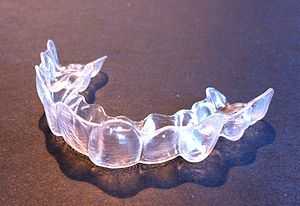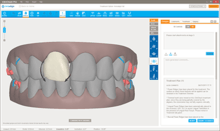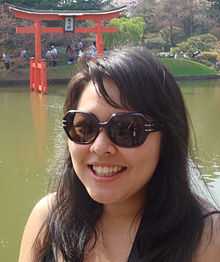Invisalign
 | |
 An Invisalign aligner | |
| Public | |
| Traded as | ALGN |
| Industry | Orthodontic |
| Founded | 1997 |
| Founder | Zia Chishti and Kelsey Wirth |
| Headquarters | San Jose, California, United States |
Key people | Thomas Prescott, Chief Executive Officer |
| Products | Invisalign, iTero Scanner and Orthocad products |
| Revenue | $560 million[1] |
Number of employees | 3,200[1] |
| Website |
www |
Invisalign is an orthodontic device that uses transparent, incremental aligners to adjust teeth as an alternative to wire braces. It is manufactured by Align Technology, a multinational medical device company headquartered in San Jose, California. The Invisalign treatment process involves taking a mold of the patient's teeth that is scanned in order to create a computerized model. Using the orthodontist's treatment plan, the computer model creates stages between the current and desired teeth positions that are used to create molds for individual aligners.
Invisalign's manufacturer and developer, Align Technology, was founded in 1997. The Invisalign product was approved by the Food and Drug Administration in 1998. $140 million in venture capital was raised from 1997 to 2000 and another $130 million was raised in an initial public offering in 2001. The founder Zia Chishti, after being ousted from the company in 2002, started Orthoclear in 2005, which resulted in several legal disputes. By 2012, there had been two million Invisalign patients and most dentists and orthodontists in North America had been trained on the Invisalign system.
As of 2005, it is unclear how well Invisalign work as they have not been well studied.[2] No further systematic reviews have been published between 2005 and 2014.[3]
Medical uses
As of 2005 it is unclear how well they work as they have not been properly studied.[2] No further systematic reviews have been published between 2005 and 2014.[3] They are likely useful for tooth crowding of the front teeth that is of a moderate degree.[3] In those with teeth that are either too far forward, too far backward, or rotated in the socket it is likely not as good as conventional braces.[3] Additionally the teeth more often become misaligned again.[3] A 2013 Cochrane review found no high quality evidence with respect to the management of the recurrence of lower front teeth misalignment following prior treatment.[4]
Invisalign are probably more noticeable than lingual braces.[3] They are; however, likely more comfortable, can be removed making cleaning of the teeth easier, and faster for the dentist to apply.[3]
History
Origins
Zia Chishti conceived of the basic design of InvisAlign while an adult orthodontics patient. During his treatment with a a retainer intended to complete his treatment, he posited a series of such devices could effect a large final placement in a series of small movements. He partnered with Kelsey Wirth to seek developers.[5][6] Chishti and Wirth joined fellow Stanford students Apostolos Lerios and Brian Freyburger to co-found Align Technology in 1997.[6] They obtained funding from Kleiner Perkins Caufield and Byers and began development in a garage in Menlo Park, California.[7] Lerios and Freyburger were graduate students working with Marc Levoy in the computer graphics lab at Stanford. They researched capturing the geometry of objects in CAD models, and the use of 3D printers to replicate the object calling it the 3D Fax project. Their use of these technologies allowed them to develop the programming that designed incremental retainers.[6] The Invisalign system was approved by the Food and Drug Administration in 1998[5][8] and sales began in the U.S. in 1999.[9][10]
Establishment
Orthodontists were resistant to adopting Invisalign at first, in particular because the founders had no orthodontic credentials or expertise, but the product became popular among consumers.[5] In 2000 Align Technology planned a $31 million television advertising campaign that The New York Times said would be “the most aggressive consumer advertising plan the dental profession has ever seen.”[11] The company raised about $140 million in funding over four rounds from 1997 to 2000.[6][11][12] $130 million in additional funding was raised in 2001 through an initial public offering on NASDAQ.[6][13] By 2001, 75 percent of the 8,500 orthodontists in North America had been trained on the Invisalign system.[6][14] That same year, Align Technology made Invisalign available to general dentists following a class-action lawsuit that alleged making the system available only to orthodontists resulted in unfair competition for dentists.[6][14]
In the early 2000s, Align Technology was spending nearly all of its revenues on marketing and advertising. It was losing about $18 million per year.[15][16] Cofounders Wirth and Chishti resigned from Align Technology in 2001 and 2003 respectively,[8] with Thomas Prescott replacing Chishti as CEO in March 2002. Prescott re-focused the company on North America and cut the marketing budget to about one-third its original size.[15][16]
In 2005, Chishti and others created competitor OrthoClear.[8] This resulted in a legal dispute regarding alleged patent infringement by OrthoClear[17] and a series of lawsuits whereby both Align and OrthoClear alleged the other had engaged in false advertising, defamation and trademark infringement, among other things. The “longstanding round of bitter litigation” was settled in 2006.[8][18] Align paid OrthoClear $20 million and OrthoClear agreed to end its operations.[17]
The Invisalign system grew from 80,000 patients in 2002 to 175,000 in 2004. It won several awards for stereolithography, medical design and fast-growth. Align Technology was profitable for the first time in 2003. In 2005 the company expanded into Japan[15] and acquired General Orthodontic, an orthodontics firm that supported doctors prescribing the Invisalign system.[1][15] Later that year the Harvard School of Dental Medicine began requiring that its orthodontic graduate students complete Invisalign certification before they graduate.[15] By 2008 more than 500,000 patients had used Invisalign,[19] which grew to two million by 2012.[1]
Recent developments
In 2007 the Academy of General Dentistry approved Align Technology's Program Approval for Continuing Education (PACE) program.[1] The company also created the AlignTech Institute, which provides educational resources to doctors.[20] In 2009, Align Technology began to require that doctors prescribing Invisalign complete at least ten cases per year and ten hours of training in order to maintain their Invisalign provider status. In January 2010, 20,000 doctors had their certification suspended for not meeting the requirements, but a class action lawsuit regarding providers that paid for training under the original rules resulted in some certifications being re-instated.[21] In March 2011, Align Technology acquired Cadent System, Inc., a dentist firm, for $190 million.[22]
Align Technology
As of 2012, 92 percent of Align Technology's revenues were from sales of Invisalign, 76 percent of which came from the US market.[1] The company also produces iTero scanner products and OrthoCAD digital services.[1] It supports several different types of Invisalign treatment plans. In addition to the default "Full" version, there is a Teen version with wear indicators and replacements for lost aligners. An Assist version provides additional tools and services to assist the doctor and several Express versions have fewer aligners at a lower cost for minor adjustments.[1] Align Technology also produces retainers used after treatment under the Vivera brand.[1]
The Invisalign Express 10, which uses 10 aligners, was introduced in 2005.[23] The Vivera brand retainers were developed in 2007 and Invisalign Teen was released the following year.[1] Invisalign 1.5 was released in 2009. It was followed by Invisalign G3 in 2010 and G4 in 2011. Invisalign G3 and G4 were designed for more complex treatments. An Invisalign Express 5 version, which uses 5 aligners, was introduced in 2012.[17] In February 2014, Align Technology released a G5 product designed to treat deep bites.[24]
Support, software engineering, pre-production and administrative functions are done from Align Technology's headquarters in California. The manufacturing of Invisalign aligners is performed in Mexico[6] and treatment plans are created in Costa Rica. Align Technology also operates separate subsidiaries in Hong Kong and Australia that sell Invisalign in their respective markets.[20] Align Technology provides training and certification to doctors,[9][25] as well as equipment and aligners related to the Invisalign system.[1]
Treatment process

Treatment begins with a doctor taking x-ray, photographs, a bite registration and polyvinyl siloxane impressions of the patient's teeth and gums. The dentist/orthodontist completes a written evaluation that includes diagnosis and treatment plan.[5][7][9][26] Dental impressions are sent to be scanned to create a digital 3D representation of the patient's teeth.[7][9] Technicians move the teeth to the desired location with the program Treat, which creates stages between the current and desired teeth positions.[9][26][27] Anywhere from six to forty-eight aligners may be needed. Each aligner moves teeth .25 to .33 millimeters.[5][28]
A computer graphic representation of the projected teeth movements is provided to the doctor and patient in a software program called ClinCheck for approval or modification before aligners are manufactured.[5][9][27] The aligners are modeled using CAD-CAM (computer-aided-design and computer-aided-manufacturing) software and manufactured using a rapid prototyping technique called stereolithography.[7][9] The molds for the aligners are built in layers using a photo-sensitive liquid resin that cures into a hard plastic when exposed to a laser.[7] The aligners are made from an elastic thermoplastic material that applies pressure to the teeth to move into the aligner's position.[27][29][30] Patients that need a tooth rotated or pulled down may have a small tooth-colored[31] composite attachment bonded onto certain teeth.[27] More attachments can make the aligners less aesthetically pleasing.[9] Reproximation, (also called interproximal reduction or IPR and colloquially, filing or drilling), is sometimes used at the contacts between teeth to allow for a better fit.[32][33]
Each aligner is intended to be worn 20 hours a day for two weeks.[28] On average the treatment process takes 13.5 months.[34] Treatment time varies based on the complexity of the planned teeth movements.[28] Refinements may be ordered by the doctor during the treatment process.[19] The aligner is removed for brushing, flossing and eating.[10] Once the treatment period has concluded, the patient is advised to continue wearing a retainer at night for the foreseeable future.[19]
When the Invisalign system was first developed, many of the aligner manufacturing processes were done by hand and computer technicians had to modify each tooth in the computerized model individually.[7]
Cost

The main disadvantages of Invisalign in comparison to conventional orthodontic treatment are cost and technical limitations in handling complex cases.[35] In a typical case, conventional braces treatment may cost $4,000, while Invisalign would be $5,600 and insurance may cover $1,000 of either treatment.[6]
References
- ↑ 1.0 1.1 1.2 1.3 1.4 1.5 1.6 1.7 1.8 1.9 1.10 Align Technology, Inc. SWOT Analysis. (2013). 1-8.
- ↑ 2.0 2.1 Lagravère, MO; Flores-Mir, C (December 2005). "The treatment effects of Invisalign orthodontic aligners: a systematic review.". Journal of the American Dental Association (1939) 136 (12): 1724–9. doi:10.14219/jada.archive.2005.0117. PMID 16383056.
- ↑ 3.0 3.1 3.2 3.3 3.4 3.5 3.6 Kuncio, DA (March 2014). "Invisalign: current guidelines for effective treatment.". The New York state dental journal 80 (2): 11–4. PMID 24851387.
- ↑ Yu, Y; Sun, J; Lai, W; Wu, T; Koshy, S; Shi, Z (6 September 2013). "Interventions for managing relapse of the lower front teeth after orthodontic treatment.". The Cochrane database of systematic reviews 9: CD008734. doi:10.1002/14651858.CD008734.pub2. PMID 24014170.
- ↑ 5.0 5.1 5.2 5.3 5.4 5.5 Basavaraj Subhashchandra Phulari (June 30, 2013). History of Orthodontics. JP Medical Ltd. ISBN 978-93-5090-471-8.
- ↑ 6.0 6.1 6.2 6.3 6.4 6.5 6.6 6.7 6.8 Coughlan, Anne; Julie Hennessy, Invisalign: Orthodontics Unwired, Kellogg School of Management }
- ↑ 7.0 7.1 7.2 7.3 7.4 7.5 Tuncay, Orhan (2006). The Invisalign System. Quintessence Publishing Co, Ltd. ISBN 1850971277.
- ↑ 8.0 8.1 8.2 8.3 "OrthoClear, Align end lengthy legal fight". Silicon Valley Business Journal. September 28, 2006. Retrieved January 9, 2013.
- ↑ 9.0 9.1 9.2 9.3 9.4 9.5 9.6 9.7 Thomas Rakosi; Thomas M. Graber (2010). Orthodontic and Dentofacial Orthopedic Treatment. Thieme. ISBN 978-3-13-127761-9.
- ↑ 10.0 10.1 Isaacs, Barbara (February 25, 2001). "Good riddance to metal-mouth misery". Knight Ridder. Retrieved January 9, 2013.
- ↑ 11.0 11.1 Feder, Barnaby J. (18 August 2000). "Orthodontics Via Silicon Valley; A Start-Up Uses Computer Modeling And Venture Capital to Reach Patients". The New York Times. p. 1.
- ↑ Liedtke, Michael (September 23, 2000). "Using new software, dentists straighten teeth without braces". Associated Press. Retrieved January 9, 2014.
- ↑ Liedtke, Michael (January 26, 2001). "Align Technology Raises $130 Million in IPO". Associated Press. Retrieved January 9, 2014.
- ↑ 14.0 14.1 Bush, Jewel (August 14, 2001). "Stealth Braces". NYT Regional Newspapers. Retrieved January 9, 2013.
- ↑ 15.0 15.1 15.2 15.3 15.4 Gretchen, Antelman (2008). International Directory of Company Histories 94. St. James Press. pp. 15–18. ISBN 1-55862-615-8.
- ↑ 16.0 16.1 Lau, Gloria (May 3, 2004). "It has a bracing impact on patients; Align Technology".
- ↑ 17.0 17.1 17.2 Benesh, Peter (March 19, 2007). "No More Mouthfuls of Metal". Investor's Business Daily. Retrieved January 9, 2013.
- ↑ "Align Technology and OrthoClear end Litigation" (PDF). Ortho Tribune. October 16, 2006. Retrieved January 7, 2013.
- ↑ 19.0 19.1 19.2 Sultan, Aisha (January 21, 2008). "Braces offer ‘invisible’ fix". St. Louis Post-Dispatch. Retrieved January 9, 2014.
- ↑ 20.0 20.1 Jack W. Plunkett (March 1, 2009). Plunkett's Companion to the Almanac of American Employers 2009: Mid-Size Firms. Plunkett Research, Ltd. p. 134. ISBN 978-1-59392-126-2.
- ↑ Rasmussen, March (March 2011), Invisalign Agrees to Settlement in Class Action Lawsuit, American Dental Association, retrieved March 25, 2014
- ↑ "Restructuring Roundup: Align to close New Jersey facility, will cut 119 jobs". Medical Device Daily. September 9, 2011.
- ↑ "Medical Devices; Pricing simplified for Invisalign". Science Letter. December 27, 2005.
- ↑ "Treatment of deep bite malocclusions". BDJ 216 (5): 260–260. 2014. doi:10.1038/sj.bdj.2014.164. ISSN 0007-0610.
- ↑ Robert R. Edwab (2003). Essential Dental Handbook: Clinical and Practice Management Advice from the Experts. PennWell Books. p. 412. ISBN 978-0-87814-624-6.
- ↑ 26.0 26.1 Bishop A, Womack R, and Derakhshan M. (Sep-Oct 2002)., "An esthetic and removable orthodontic treatment option for patients: Invisalign", The Dental Assistant: 14
- ↑ 27.0 27.1 27.2 27.3 Birte Melsen (3 February 2012). Adult Orthodontics. John Wiley & Sons. pp. 353–. ISBN 978-1-4443-5574-1.
- ↑ 28.0 28.1 28.2 Malik, Ovals; McMullin, Allbhe; Waring, David (April 2013). "Invisible Orthodontics Part 1: Invisalign". Dental Update. PMID 23767109.
- ↑ Cowley, Daniel (August 1, 2012), Effect of Gingival Margin Design on Retention of Thermoformed Orthodontic Aligners, University of Nevada, retrieved March 11, 2014
- ↑ Alexander, Justin (2012), Effect of Reducing the Incremental Distance of Tooth Movement per Aligner while Maintaining Overall Rate of Movement on Self-Reported Discomfort in Invisalign Patients (PDF), Saint Louis University, retrieved March 11, 2014
- ↑ Joffe, L. (2003). "Invisalign(R): early experiences". Journal of Orthodontics 30 (4): 348–352. doi:10.1093/ortho/30.4.348. ISSN 1465-3133. PMID 14634176.
- ↑ Humber, PV. (2008), "A Snapshot of Invisalign", Aesthetic Dentistry Today 2 (1): 85–88, retrieved 2011-01-28
- ↑ Boyd RL (August 2008), "Esthetic orthodontic treatment using the invisalign appliance for moderate to complex malocclusions", Journal of Dental Education 72 (8): 948–67, PMID 18676803, retrieved January 28, 2011
- ↑ Fogel, Joshua; Janani, Raymond (2010). "Intentions and behaviors to obtain Invisalign". Journal of Medical Marketing 10 (2): 135–145. doi:10.1057/jmm.2009.50. ISSN 1745-7904.
- ↑ Shalish, M.; Cooper-Kazaz, R.; Ivgi, I.; Canetti, L.; Tsur, B.; Bachar, E.; Chaushu, S. (2011). "Adult patients' adjustability to orthodontic appliances. Part I: a comparison between Labial, Lingual, and Invisalign". The European Journal of Orthodontics 34 (6): 724–730. doi:10.1093/ejo/cjr086. ISSN 0141-5387.
| ||||||||||||||||||||||||||||||||||||||||||||||||||||||||||||||